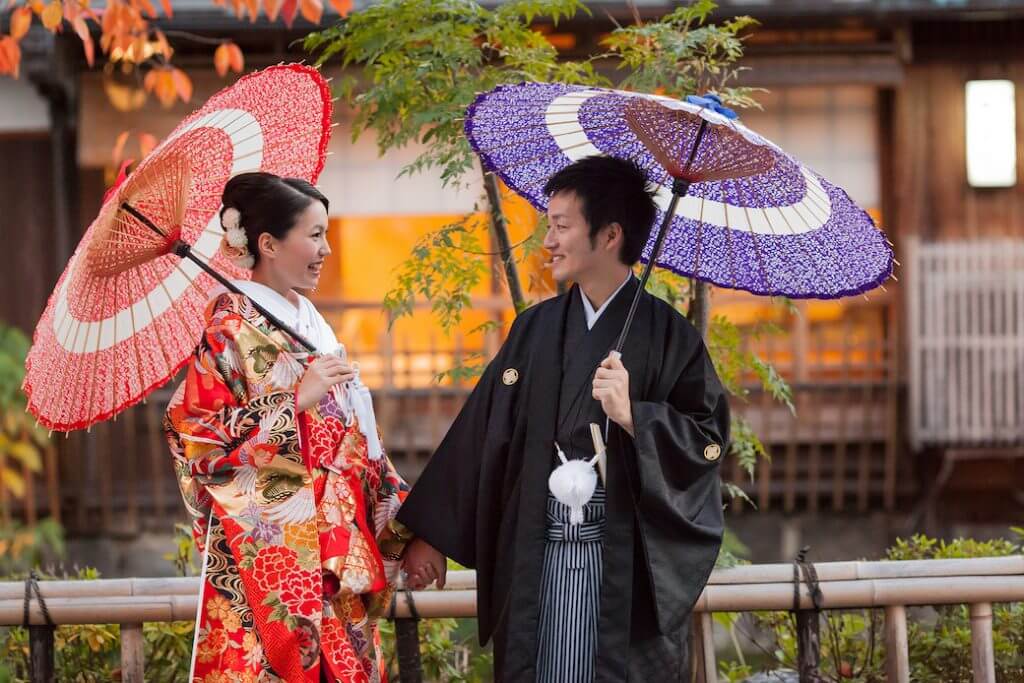Mariage traditionnel japonais
J'ai eu la chance, ce mois-ci, de voyager au Japon et de découvrir l'incroyable culture et l'atmosphère paisible qui émanent de partout. Le respect, la politesse et la tradition sont essentiels ici. En explorant les îles de Kyushu et Honshu, je suis tombée sur tant de chapelles au design exquis et sophistiqué que je me suis sentie obligée d'en apprendre plus sur les traditions japonaises en matière de mariage. Alors que de nombreux couples japonais recherchent une cérémonie moderne de type occidental et considèrent les anciennes croyances et coutumes comme démodées, les cérémonies traditionnelles sont encore très populaires et courantes.
Le mariage japonais étant une affaire de famille, il était courant pour les familles de trouver une personne de confiance pour jouer le rôle d'entremetteur ( nakoudo ). Cette coutume s'appelle l'Omiai. J'ai rapidement acquis une meilleure compréhension du film de Disney Mulan ! S'assurer que les futurs mariés sont dignes de confiance et qu'ils ont reçu une bonne éducation était une tâche importante. Une fois que tout était approuvé par l'entremetteuse, le marié ( shinrou ) était présenté à la mariée ( shimpu ). Les invitations au mariage étaient envoyées aux invités au nom des parents. La première cérémonie était religieuse et seuls les membres de la famille y assistaient. La cérémonie était suivie d'un cocktail, puis le reste des invités était convié à la célébration. Il est toujours fortement recommandé aux invités de remettre au couple des enveloppes contenant de l'argent, appelées Goshuugi. En retour, les invités recevaient des faveurs coûteuses ou de petits cadeaux appelés hikidemono. Pour s'assurer de la bonne fortune future, des plats coûteux tels que des daurades et des crevettes tigrées étaient servis en abondance lors de la réception.
Le mariage traditionnel de style shintoïste est récemment revenu à la mode. Il se déroule toujours en présence de la famille proche des mariés et est suivi d'une réception plus importante. Les mariés portent des kimonos en soie et un prêtre shintoïste ( kannushi ) officie la cérémonie. Celle-ci commence par la cérémonie du harai-gushi, au cours de laquelle il agite trois fois des bandes de papier blanc attachées à un bâton afin de purifier la pièce et les invités. Les costumes traditionnels portés sont à la fois complexes et flamboyants. La mariée porte une perruque et recouvre son visage d'un maquillage blanc pâle qui permet de dissimuler ses traits à la vue de tous. Elle porte un tsuno-kakushi (chapeau à cornes) qui est censé cacher les "cornes de jalousie" de la mariée - une tradition ancienne qui remonte à la période Muromachi du XIVe siècle, lorsque les femmes de la classe supérieure se couvraient la tête lorsqu'elles s'aventuraient à l'extérieur. Au cours de la cérémonie, le couple boit une petite coupe de saké qui "scelle" le mariage. Afin d'éloigner les mauvais esprits et d'attirer l'attention des divinités, le couple applaudit deux fois à la fin de la cérémonie et invite tous les invités à faire de même. Ce geste est similaire à celui des Japonais qui applaudissent deux fois au sanctuaire shinto avant d'offrir une prière.



